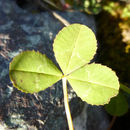Description
provided by eFloras
Procumbent, ascending or erect annual, glabrous. Leaflets 7-30 mm long, obovate-cuneate. Inflorescence a peduncled head, 1.0-1.5 cm wide, globose, many flowered, without an involucre. Peduncle longer than the subtending leaf. Calyx inflated in fruit, 5-10 mm long, glabrous to subglabrous. Corolla pink to reddish purple, resupinate. Vexillum 6-10 mm long. Fruit shortly ovoid, enclosed by inflated calyx.
- license
- cc-by-nc-sa-3.0
- copyright
- Missouri Botanical Garden, 4344 Shaw Boulevard, St. Louis, MO, 63110 USA
Distribution
provided by eFloras
Distribution: Pakistan; Afghanistan; Syria; Iraq; Turkey; Egypt; N.Africa; Southern USSR; introduced in W. & C. Europe, probably native of S.Europe.
- license
- cc-by-nc-sa-3.0
- copyright
- Missouri Botanical Garden, 4344 Shaw Boulevard, St. Louis, MO, 63110 USA
Physical Description
provided by USDA PLANTS text
Annual, Herbs, Taproot present, Nodules present, Stems erect or ascending, Stems or branches arching, spreading or decumbent, Stems less than 1 m tall, Stems solid, Stems or young twigs glabrous or sparsely glabrate, Leaves alternate, Leaves petiolate, Stipules conspicuous, Stipules green, triangulate to lanceolate or foliaceous, Stipules persistent, Stipules clasping stem at the base, Stipules adnate to petiole, Leaves compound, Leaves palmately 2-3 foliate, Leaflets dentate or denticulate, Leaflets 3, Leaves glabrous or nearly so, Inflorescences racemes, Inflorescences globose heads, capitate or subcapitate, Inflorescence axillary, Inflorescence terminal, Bracteoles present, Flowers zygomorphic, Flowers resupinate, banner in inverted or lateral position, Calyx 5-lobed, Calyx glabrous, Petals separate, Corolla papilionaceous, Petals clawed, Petals pinkish to rose, Banner petal narrow or oblanceolate, Wing petals narrow, oblanceolate to oblong, Wing petals auriculate, Wing tips obtuse or rounded, Keel tips obtuse or rounded, not beaked, Stamens 9-10, Sta mens diadelphous, 9 united, 1 free, Filaments glabrous, Style terete, Style persistent in fruit, Fruit a legume, Fruit unilocular, Fruit indehiscent, Fruit oblong or ellipsoidal, Fruit orbicular to subglobose, Fruit or valves persistent on stem, Fruit enclosed in calyx, Fruit glabrous or glabrate, Fruit 1-seeded, Seeds cordiform, mit-shaped, notched at one end, Seed surface smooth, Seeds olive, brown, or black.
Trifolium resupinatum: Brief Summary
provided by wikipedia EN
Trifolium resupinatum (reversed clover, Persian clover, shaftal, syn. T. resupinatum L. var. majus Boss., T. suaveolens Willd.) is an annual clover used as fodder and hay, which reaches 60 cm (24 in) tall when cultivated, and forms rosettes when grazed or mowed. It is native to central and southern Europe, the Mediterranean, and southwest Asia as far south as the Punjab. It is an important hay crop in cold regions of Iran, Afghanistan and other Asian areas with cold winters.
- license
- cc-by-sa-3.0
- copyright
- Wikipedia authors and editors

